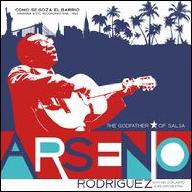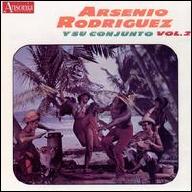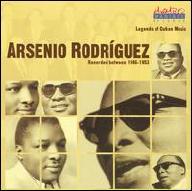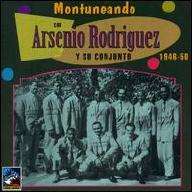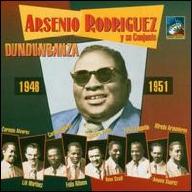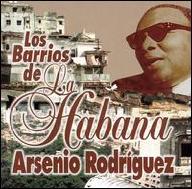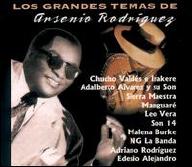A descendent of Congolese slaves, Rodríguez was born on August 31, 1911, in Guira de Macurije in Cuba's western province, Mantanzas. At age seven Rodríguez was blinded by a horse's kick; he would later become know as "El Ciego Maravilloso" (The Marvelous Blind One). As a child, he began playing a variety of instruments, including Afro-Cuban drums and percussion, bass, and tres, a Cuban six-string guitar that would become his primary instrument. Some important early influences on tres included Nene Malfugas, Isaac Oviedo, and Eliseo Silviera. He began composing in his teens and in the early '30s formed El Sexteto Boston. In 1937 he joined trumpeter José Interain's Septeto Bellamar. 1937 also saw the first recordings of Rodríguez's compositions; Miguelito Valdés sang Bruca Manigua, Ven Acá Tomas, and Fuñfuñando with Orquesta Casino de la Playa.
During this period, the standard format for playing son was the septeto, consisting of trumpet, guitar, tres, bongos, bass, maracas, and claves, with two or more bandmembers singing. The general trend in the 1930s had been for the son to stray somewhat from its African roots, adopting a more subdued sound. This would all change around 1940 when Rodríguez added conga drum, piano, and a second (and later third) trumpet to the typical son ensemble, giving birth to the conjunto. The conjunto format revolutionized the son with the added drive provided by the conga's deep tone and the trumpet section's power. Around this time, Rodríguez introduced the son montuno, a son with a montuno section featuring improvised vocals (soneos) by the lead singer (sonero) over a repeated chorus; trumpet, tres, and piano solos also occurred frequently. Rodríguez is also credited, along with bandleaders Antonio Arcaño and Pérez Prado, with developing the mambo rhythm during this period. Another key innovation was the band's adaptation of the guaguancó to the dance band/conjunto format. The guaguancó is an Afro-Cuban style traditionally performed by voices and percussion; Rodríguez mixed some of its melodic and formal elements with those of the son. These further "Afro-Cubanizations" of the son are among Rodríguez's most important and lasting contributions. The conjunto format, son montuno, and mambo are three essential elements of what would later be called salsa.
The 1940s were a classic period in Rodríguez's career and the history of the son. Many of his most famous compositions were recorded, including A Belen Le Toca Ahora, La Yuca de Catalina, Juventud Amaliana, and perhaps his most famous work, the bolero La Vida es un Sueño, which was written after an unsuccessful attempt to restore his sight in 1947. Among his bandmembers during the '40s were several key figures in the development of the son, namely vocalists Miguelito Cuní, Marcelino Guerra, and René Scull, trumpeters Felix Chappotin and Chocolate Armenteros, and pianist Lilí Martínez. This period is represented on several reissue CDs: Montuneando con Arsenio Rodríguez y Su Conjunto (Tumbao), Legendary Sessions: Chano Pozo and Arsenio Rodríguez (Tumbao), Dundunbanza (Tumbao), A Todos los Barrios (RCA), and Oye Como Dice (Cubanacan).
In 1953, Rodríguez moved to New York, leaving his conjunto in Cuba under the leadership of trumpeter Chappotin, who would become a legend in his own right. Compositions such as La Gente del Bronx and Como se Goza en el Barrio (both available on the Tumbao CD named after the latter) continued to reflect his gift for writing about his everyday surroundings. His popularity in New York, while strong, would never match what it had been in Cuba. The mid-'50s saw the release of a strong album, Sabroso y Caliente (reissued on CD on Antilla), which added flute and timbales to the conjunto setup. El Ciego Maravilloso would continue to experiment with different instrumentations for the rest of his career, at times adding one or more saxophones to his band.
In the late '50s, Rodríguez recorded Primitivo and appeared, under the leadership of conguero Sabu Martinez, on the Blue Note release Palo Congo, which featured his brothers and conjunto sidemen Quique and Caesar Rodríguez. This album includes chants from Palo Congo, an Afro-Cuban religion of Congolese origin. In the early '60s, Rodríguez recorded Quindembo/AfroMagic (Epic), an innovative experimental album on which he wrote and sang on all the tracks. Rodríguez called this style, which blends jazz influences with son and more earthy Afro-Cuban religious elements, "Quindembo," a Congolese word meaning a mixture of many things. Around this time he also recorded two very strong albums in the conjunto style, Arsenio Rodríguez y Su Conjunto, Vol. 1 and Vol. 2. In his final years he continued to experiment, developing a style he called "swing son." The last album Rodríguez recorded was Arsenio Dice, a 1968 Tico release. On December 30, 1970, "El Ciego Maravilloso" died of pneumonia in Los Angeles. As a composer, performer, and musical experimenter, Rodríguez was one of the undoubted giants of Cuban music. In the United States, he was a decisive influence in the '60s and '70s tipico movement, and his experimentation pointed to way to some of the developments made by the more adventurous architects of salsa, such as Willie Colón. His legacy is recognized on several tribute albums, including Larry Harlow's Tribute to Arsenio Rodríguez and Tico's all-star Recordando a Arsenio. ~ Nick Herman, Rovi


